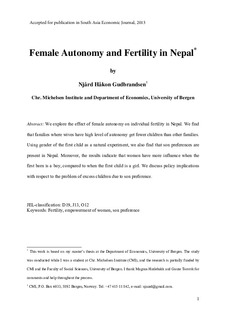| dc.contributor.author | Gudbrandsen, Njård Håkon | |
| dc.date.accessioned | 2018-01-04T08:23:46Z | |
| dc.date.issued | 2013-05-01 | |
| dc.identifier | oai:www.cmi.no:4766 | |
| dc.identifier.citation | in South Asia Economic Journal vol. 14 no. 1 pp. 157-173 | |
| dc.identifier.issn | 0973-077X | |
| dc.identifier.uri | http://hdl.handle.net/11250/2475445 | |
| dc.description.abstract | We explore the effect of female autonomy on individual fertility in Nepal. We find that families where wives have high level of autonomy have fewer children than other families. Using gender of the first child as a natural experiment, we also find that son preferences are present in Nepal. Moreover, the results indicate that women have more influence when the first born is a boy, compared to when the first child is a girl. We discuss policy implications with respect to the problem of excess children due to son preference. | |
| dc.language.iso | eng | |
| dc.relation | South Asia Economic Journal | |
| dc.relation | 1 | |
| dc.relation.ispartof | South Asia Economic Journal | |
| dc.relation.ispartofseries | South Asia Economic Journal vol. 14 no. 1 | |
| dc.relation.ispartofseries | South Asia Economic Journal vol. 14 no. 1 | |
| dc.relation.uri | https://www.cmi.no/publications/4766-female-autonomy-and-fertility-in-nepal | |
| dc.subject | Nepal | |
| dc.title | Female Autonomy and Fertility in Nepal | |
| dc.type | Journal article | |
| dc.type | Peer reviewed | |
| dc.identifier.doi | 10.1177/1391561413477945 | |
| dc.identifier.doi | 10.1177/1391561413477945 | |
